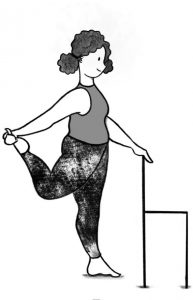Andrew McGonigle has been studying anatomy for over twenty years, originally training to become a doctor and then moving away from Western medicine to become a yoga teacher, massage therapist and anatomy teacher. He combines all of his skills and experience to teach anatomy and physiology on Yoga Teacher Training courses internationally and runs his own online Anatomy and Physiology Applied to Yoga courses. His new book, Supporting Yoga Students with Common Injuries and Conditions, is out now. In this article, using our hip joints as an example, Andrew explains why yoga practice and what feels comfortable varies for each of us.
Have you ever wondered why certain yoga postures can feel so easeful in your body while others can feel like such a challenge?
Or why one person can sit cross-legged for hours having never practiced yoga and you still need to sit on four cushions after practicing yoga for years?
The short answer to this is that every body is entirely unique and will express a certain yoga pose in a completely unique way. There are also emotional, psychological and nervous system components that affect how much movement our joints make and the quality of that movement.
Let’s explore some of these factors using our hip joints as an example.

Your hip joints are “ball and socket” joints and are the relationship between the femur bone (thighbone) and the acetabulum (hip socket) of your hipbone that makes up part of your pelvis.
- The boney structure of the femur varies immensely from person to person
The femur has a neck that lies between the head and the shaft of the bone and the angle of the neck can range from between 110° to 150° for most people. This angle will impact the ease at which you can take your leg directly out to the side (known as abduction of the hip joint). The head of the femur can also be tilted slightly forward, back, up or down in relation to the shaft. These variations may impact the degree to which you can move your leg directly in front of you or behind you, or how much you can rotate your femur inwards or outwards.
- The boney structure of the hip socket varies immensely from person to person
While one person has a shallow hip socket the person next to them may have a much deeper socket. This will potentially have a huge impact the range of movement of the hip joint in all of its directions. Some people have a hip socket that is positioned slightly further forward or further back, angled upwards or downwards. There are an infinite number of possibilities here and this is why we are each so unique!
- The right is always different to the left!
No one has a right hip joint that is architecturally the same as their left hip joint. This means that your right hip joint will move in a unique way and have a unique range of movement compared to the left. While practicing Trikonasana (Triangle Pose) easily on the right you might find the left side uncomfortable and need to step your feet closer.
- The joint capsule, ligaments, muscle and fascia all hold tension
There is a joint capsule and ligaments surrounding each of your hip joints that are there to support the joint structures and prevent dislocation (i.e. stopping the bony parts that are meeting from moving too far out of place). These structures hold tension and will limit your range of movement in different ways depending on various factors. Muscles and fascia also surround the joint and the suppleness of these tissues will vary greatly from person to person.
- There is also compression from different surrounding tissues
Subcutaneous fat, blood vessels, nerves and organs can often get in the way when we are moving our hip joints in different directions. Sometimes we can move around these obstacles but often compressive forces cannot be bypassed and need to be humbly accepted.

The difference between compression and tension
Compression is when two opposing forces meet. This can be classified as soft compression when soft tissue meets soft tissue e.g. the flesh of your stomach pressing into the flesh of your thigh, medium compression when soft tissue meets hard tissue e.g. when the flesh of your thigh presses into your hip bone, or hard compression when hard tissue meets hard tissue e.g. your femur presses into your hip bone. Compression is typically experienced in the direction of the movement that is happening. So if you are folding forward and feel sensation in the front of your hip this is likely to be compression. Sometimes there are small adjustments that we can make when we experience compression that will allow us to move a little further but often compression is a sign that we have reached our natural limit.
Tension is when two opposing forces move apart. As mentioned above, the structures within our joints that hold tension include the joint capsule, ligaments, fascia, muscles and tendons. Tension is typically experienced behind the direction of the movement. If you are experiencing tension in a forward fold you will most likely feel this behind the direction of the movement i.e. along the back of your body. There are many reasons why a muscle can become tense; as a result of overuse of a particular muscle group, following an injury in order to prevent further injury and support healing, due to underuse and therefore weakness of a muscle group or because of compensation due to a related muscle not working effectively. An effective way to reduce muscular tension is work on both stretching and strengthening that muscle group.
Yoga is a wonderful practice to help us to develop a deep sense of awareness of our bodies, accept our limitations and celebrate our uniqueness.

